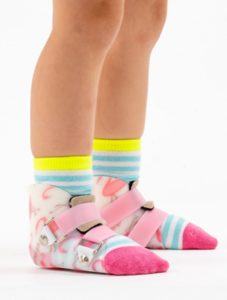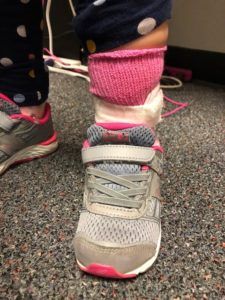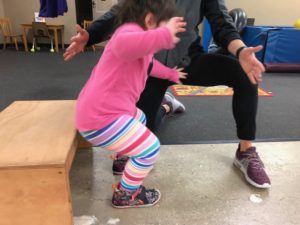Orthotics
From time to time, you may see someone with a brace on and wonder what it is for. You may even see kiddos with braces on too. When you think of a brace, the first thing that probably comes to mind is: “they must have some sort of injury”. Although braces and splints are oftentimes related to injury, more often than not they are used to help provide support to an area of the body that has poor muscle function, low muscle tone, or just needs a little more than what their body as able to provide. It also may be that they help put that particular body part/region in a more appropriate alignment and/or may even be providing a low-load, long duration stretch to help manage things such as chronic muscle tightness, high muscle tone, or contractures. A contracture is defined as “a condition of shortening and hardening of muscles, tendons, or other tissue, often leading to deformity and rigidity of joint” (Oxford dictionary). This ultimately will improve their passive range of motion and allow a therapist to help the kiddo move through that new passive range and therefore improve strength and active range of motion needed for activities.
The most common brace or orthotic you will most likely see or encounter personally with yourself or child are those used for the foot, ankle or leg (aka lower extremity). Orthotics for the lower extremity range from shoe inserts to a small brace that stops just above the ankle to those that go higher up the leg. Starting at the least supportive orthotic, shoe inserts are typically used to help provide arch support and put the foot in optimal alignment to correct or prevent ailments such as pain in the foot, leg, or back as well as improve someone’s overall walking mechanics to prevent future injury. Next, there are the orthotics that go to the level of the ankle. These are called supramalleolar orthotics or SMO’s for short. These are common orthotics that can provide the alignment correction of a foot orthotic with additional support at the ankle. They are often used for kiddos who need a little more stability to either learn to walk or make walking more efficient and safer as well as for those who consistently toe walk, among other reasons. Finally, those braces that go up higher provide the same benefits as the SMO’s with even more support. These are typically recommended for those who have a more significant degree of deficits.
As a parent with a kiddo whose therapist recommends a splint, brace, or orthotic, it can be worrisome. You may be thinking that you don’t want your child to have to wear one or like the way they look. It is important to know that these supportive devices are only recommended when they are absolutely needed, and are prescribed in order to make your child more functional and independent now as well as make things easier for them in the future as they grow and get older. These devices will not only help them learn how to walk, but can help them with all activities of daily living as well as skills that are important for school and community-based activities, and later in life with driving and work skills.
If you have a little one and have noticed that they often fall, have an abnormal looking walk or run, or any of the above mentioned deficits, then a splint, brace, or orthotic may be helpful. To know whether or not something like this would help, contact a therapist for an evaluation. You can find more information on our website at: www.abcpediatrictherapy.com.
Read MoreOrthotics are used for many different reasons, and can help kiddos achieve their goals. However, most parents do not know what to expect when getting orthotics for the first time. Here you will find some information that is good to know for first time orthotic users.
Wear Schedule – when wearing orthotics for the first time, it is important to know that the kiddo does not wear them 24/7 right away. Their skin, feet, and sensory system needs to accommodate to this new feeling and new positioning. Therefore, it is recommended the child start off wearing the orthotics for about 1 hour, which is typically done during the therapy session when they receive them. If the child is tolerating them well and the orthotics seem to fit correctly without need for adjustments, you slowly build tolerance by adding another hour until they are able to tolerate wearing them all of the time.

Monitor for Redness – as mentioned above, the kiddo’s systems need to get used to this new thing on their feet and this new positioning it puts their feet in. Therefore, it is normal that there may be mild pink or red areas that go away within 30 minutes or less once the orthotics are taken off. However, it is important to monitor these areas, especially if a deeper or more vibrant red color as this could indicate areas where the brace may need altered. This type of redness will take longer than 30 minutes to begin to fade. If this occurs, stop usage of the orthotics and give the therapist a call so we can assess what changes need to be made.

Shoes – majority of orthotics are designed to be worn with shoes. However, shoes that fit orthotics can be difficult to find, especially since kids grow so fast. It is recommended that you wait to buy new shoes until you have the orthotics in person, that way you can make sure they fit in the shoe before you buy them. A wider shoe usually works better, such as New Balance. There are also shoes designed to better fit orthotics, such as Plae and Striderite. However, any shoe that fits your child’s foot with the orthotic will work; there is no one particular brand that you must buy. 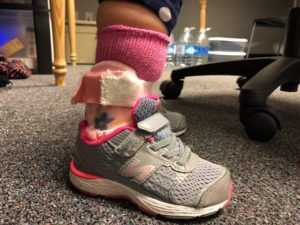
If you have any questions about the ordering process, about the fit of your child’s orthotics, or if you think orthotics may help your child, please reach out to your kiddo’s therapist. We love to help and answer all questions in order to provide the best care possible.
Read MoreThere are many reasons why a child may benefit from orthotic intervention at all different ages, with and without a medical diagnosis. The use of orthotics can vary from child to child, however, the main goal is to provide stability while promoting functional ability.
Orthotics can range from shoe inserts to knee high braces and more. They can be used to assist with flat feet, toe walking, weakness, poor balance, frequent tripping, leg length discrepancies, and etc. Orthotics are made to improve a child’s walking pattern to as normal for THEM as possible to facilitate age appropriate child development.
As a physical therapist, I hear more often than not that “my child’s doctor said they would grow out of it.” This may be the case for some children, but not all children are the same. Our posture and the way we walk begin in the womb and continue to develop through infancy and beyond. The way we walk is affected by our strength, flexibility, endurance, sensory processing, balance, and more. We cannot assume that because one child grew out of toe walking, all children will. There are many factors to consider and assess with each and every individual child.
The photos below are of a child whose mom had concerns about her foot position as soon as she began walking. Her primary care provider told her that she would grow out of it. She is now 9 years old and has significant ankle pain with running, jumping and long distant walking. With the use of custom orthotics and physical therapy services her pain has improved significantly. She will occasionally still have pain with higher impact sports, however, it is less frequent and she is now able to enjoy playing with her friends.
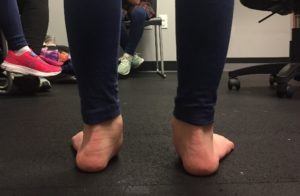
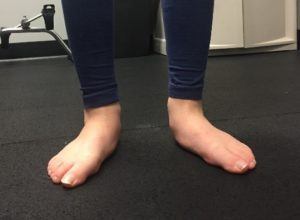
A child’s medial column of their foot, which means the middle of their foot (arch), does not fully develop until the age of 7-8 years old. This means that the forces we place upon our feet during this time frame will significantly impact the structure of them. If a child is compensating in the way they are standing, walking, running it could lead to foot abnormalities when they get older which could potentially lead to pain and/or decreased function in their day to day lives.
It is also important to note that because orthotics promote function, if a child is having difficulty learning to walk, jump, run, hop, or any gross motor activity that orthotics could be beneficial in helping facilitate those motor milestones.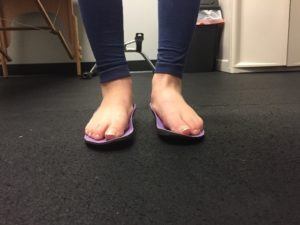
If you have concerns about your child’s foot position, posture, walking, and/gross motor development I highly recommend consulting with your pediatrician, as well as, a physical therapist to make sure that there are not underlying deficits and to determine if 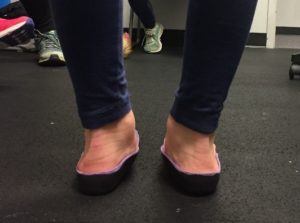 your child would benefit from orthotic intervention. There is not one specific type of orthotic for any given diagnosis or deficit. There are so many options of orthotics available and a good physical therapist will help you determine what is best for your child.
your child would benefit from orthotic intervention. There is not one specific type of orthotic for any given diagnosis or deficit. There are so many options of orthotics available and a good physical therapist will help you determine what is best for your child.
For more information on child development and therapy services visit: https://www.abcpediatrictherapy.com/
Written by: Sandra Koopmans PT, DPT
Read More
PHYSICAL THERAPY AND ORTHOTICS
Physical therapists play a critical role in identifying the need for orthotics. The decision to use orthotics is based on the assessment of range of motion, foot alignment, voluntary control of movement, muscle tone, and functional level of the child. The foot provides stability and mobility; therefore, an orthosis will affect both of these functions.
Orthotics provide stability and improved function by controlling range of motion and posture. They can be used for children who present with hypertonia or hypotonia. In children with hypertonia, orthotics reduce the influence of abnormal tonic reflexes of the foot, ankle, and leg. They decrease spasticity by prolonged stretch and pressure on the tendons of the triceps surea muscle and toe flexors. In children with hypotonia, orthotics help to correct pes planus, therefore giving the child external stability of the foot and ankle.
Children who wear orthotics present with a decreased amount of fixing and compensatory patterns because the orthotics require children to use and strengthen the appropriate muscles. Wearing orthotics result in improved motions of the pelvis, trunk, and lower extremity. They also prevent or support surgery and the use of Botox intervention.
Most Common Types of Orthotics:
- Plantar flexion stop ankle foot orthotics (AFOs) extend just distal to the knee and provide total contact with the ankle and foot. With this type of orthosis, you can choose to have free dorsiflexion control by eliminating the strap that goes around the lower leg. This type of orthosis prevents excessive ankle plantarflexion, and is used with children who require knee and ankle control.
- Supramalleolar AFOs extend just superior to the malleoli. It is used for children who have knee control, but lack ankle control. This orthosis offers the child external stabilization of the ankle and foot.
- Foot orthotics do not extend to the malleoli. Minimal control foot orthotics are shoe inserts, and maximum control foot orthotics extend just distal to the malleoli, controlling the calcaneus. These are used mostly for children who pronate and only need a small amount of support.
Physical therapists at ABC Pediatric Therapy are trained to cast and measure for orthotics. We are also trained in fitting and modifying them as necessary. We most commonly recommend Cascade or Surestep orthotics, and work closely with area orthotists. All orthotics are ordered based on the individual needs of the child. Prices can vary depending upon the type of orthosis. Insurance typically covers a portion of the cost of orthotics with a prescription from the doctor and a letter of medical necessity written by the therapist. It is recommended that parents call their insurance company to verify the benefits covered under their specific insurance plan.
If you have a client who you think could benefit from orthotics, call ABC at (513) 755-6600 –we are happy to answer any questions you may have.
Read More
 Skip to content
Skip to content
